
 Copyright 2018 by Danica Davidson and Rena Saiya All rights reserved. No part of this book may be reproduced or stored in a retrieval system or transmitted in any form or by any means, whether electronic, mechanical, photocopying, recording, or other kind, without the express written consent of the publisher, except in the case of brief excerpts in critical reviews or articles. All inquiries should be addressed to Skyhorse Publishing, 307 West 36th Street, 11th Floor, New York, NY 10018. Skyhorse Publishing books may be purchased in bulk at special discounts for sales promotion, corporate gifts, fund-raising, or educational purposes. Special editions can also be created to specifications. For details, contact the Special Sales Department, Skyhorse Publishing, 307 West 36th Street, 11th Floor, New York, NY 10018 or .
Copyright 2018 by Danica Davidson and Rena Saiya All rights reserved. No part of this book may be reproduced or stored in a retrieval system or transmitted in any form or by any means, whether electronic, mechanical, photocopying, recording, or other kind, without the express written consent of the publisher, except in the case of brief excerpts in critical reviews or articles. All inquiries should be addressed to Skyhorse Publishing, 307 West 36th Street, 11th Floor, New York, NY 10018. Skyhorse Publishing books may be purchased in bulk at special discounts for sales promotion, corporate gifts, fund-raising, or educational purposes. Special editions can also be created to specifications. For details, contact the Special Sales Department, Skyhorse Publishing, 307 West 36th Street, 11th Floor, New York, NY 10018 or .
Skyhorse and Skyhorse Publishing are registered trademarks of Skyhorse Publishing, Inc., a Delaware corporation. Visit our website at www.skyhorsepublishing.com. 10 9 8 7 6 5 4 3 2 1 Library of Congress Cataloging-in-Publication Data is available on file. Cover design by Jane Sheppard Cover illustrations by Rena Saiya Print ISBN: 978-1-5107-2952-0 eBook ISBN: 978-1-5107-2953-7 Printed in China Contents Introduction Manga has become a worldwide phenomenon. Fans of Japanese comics and animation can be found around the globe, and many of them want to express their love for these art forms by drawing in the same style. This book is the sequel to Manga Art for Beginners .
Manga Art for Beginners was a more basic book on showing newcomers how they could have fun drawing their favorite manga character types, and it made the point of using more steps than average how-to-draw-manga-character books, enabling readers to better see the creative steps. Manga Art for Intermediates continues where that left off, but also has more to offer. In this book, youll find many beloved and popular manga character types, drawn in special detail and enlarged, so you can really see whats happening. Manga Art for Intermediates assumes that, whether or not you have read Manga Art for Beginners , you have some basic knowledge of drawing. By learning how to draw various characters, the experiences can be your data base of character design and it will be helpful when you create your own characters. So it also teaches drawing on a more professional level and talks about how manga is drawn in Japan.
The art was completed by professional artist Rena Saiya from Japan; she has a background in both professional artwork for top Japanese publishers and in teaching students how to draw in the manga style. With the knowledge of what works well, what Japanese publishers look for, and what real professional artists in Japan do, Manga Art for Intermediates invites you to pick up your pen (or your computer or tablet) and experience the beautiful world of manga character drawing. Getting Started Tools Needed for Making Manga You have different options for making mangafrom software to pen on paper. Software will typically give you what you need for the different aspects of making manga, like helping you with screentones and colors. If drawing on paper, you can use pencil, and finish it up by inking it with art pens, easy-to-find ballpoint pens, or special pens used by professional mangaka (manga creators) in Japan, depending on what you want and what your budget is. This section will talk about some of those options.
Beginning with a Sketch All manga drawings start with a sketch. Any sort of paper would work. Plenty of high school students draw manga characters on printer paper or notebook paper, but professionals use thicker paper for their work. These can be found in sketchbooks sold in art stores and sometimes in retail stores in their office supply section. In Japan, the type of paper suitable for drawing monochrome manga (meaning manga using one color, like black) is called kent paper and packed kent papers are sold as manga manuscript paper at art shops. And, like so many other things these days, they can also be bought online.
In Japan, artists sometimes use mechanical pencils with blue lead for the preliminary drawing where they put down the basic outline of the character. A mechanical pencil with regular gray lead works as well. In this book, youll see blue for the preliminary drawings, then a gray pencil for more detailed penciling, followed by inking. This is one of the typical methods of manga character drawing used in Japan, and its suitable for learners at beginner or intermediate levels. Mechanical pencils arent used as much in America, but in Japan, theyre prized for their clean, straight lines and their affordable prices. In manga, you often see characters using mechanical pencils, and theres a reason for that! If you dont have blue or gray lead for a mechanical pencil, a regular wooden pencil can also work, but you have to make sure its properly sharpened for the kind of lines you want to make.
A ruler is also useful when drawing straight lines, like background buildings. It can also help you measure distance. Pens and Inking Once the drawing is done, then it is time for inking. On paper, there are different options for how you want to ink, and sometimes Japanese mangaka and American comic book inkers use different materials. A calligraphy dip pen called Speedball #102 is popular among professional comic book inkers in the United States. Other artists use Pilot ballpoint pens; these arent common in Japan, and in many cases, publishers there do not approve of using ballpoint pens.
So a ballpoint pen is not good if you want to show your work to a Japanese publisher or in a Japanese competition. However, ballpoint pens are easy to find, and if the art is just for fun or not for professional manga publishing, then they are fine to use. Specialty art pens can be bought in art stores, in some stores that sell office supplies, and online. Sometimes you can buy a pack of pens (as opposed to one pen that holds different nibs). If you notice numbers on the pens like 01 or 08, these are telling you how thick the ink line will be. Getting a starter pack of pens like this can be a good way to get started and let you experiment with ink.
Waterproof ink is recommended. In Japan, the most common types of ink are Pilot Drafting Pen Ink and Kaimei-Bokuju. Pilot Drafting Pen Ink, which is also easy to find in the United States, dries quickly and is waterproof. While pens work for the basic outlining of characters, a brush is used for filling in black spaces, like hair. Raphael series 8404 #2 or #3, Sharf brushes, and the Japanese Kuretake brush pen are all used by American inkers. Kuretake brush pens were originally made for calligraphy and later become popular with manga.
Felt nibs are often not waterproof, though they are also very useful for coloring in black hair, but there is also the option of brush nibs. Likewise, its not rare for a packet of art pens to include a brush pen. We will discuss more about inking in the following pages. What If I Make a Mistake? Have a good eraser on hand for any mistakes made while using your pencil. If you mess up while working with ink, dont worry. It happens to everyone from time to time, and there are options.
Many mangaka in Japan use Dr. Ph. Martins Bleedproof White as you might use Whiteout because it takes away the ink without ruining the picture. Software Options On a computer, things like drawing and inking can be done through special software. Manga Studio EX 4 (also called Comic Studio EX 4.0 in Japan) has been popular among Japanese manga artists for its high function of creating monochrome manga of multiple pages. Though its already finished selling in Japan, it still has a high reputation.
Next page
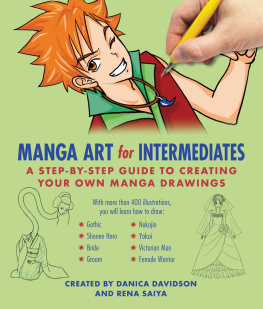
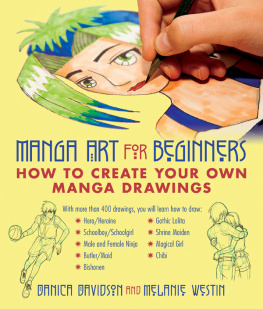
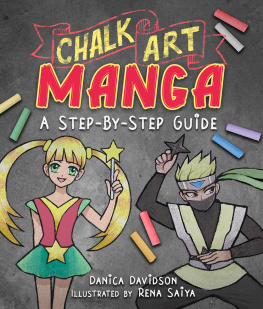
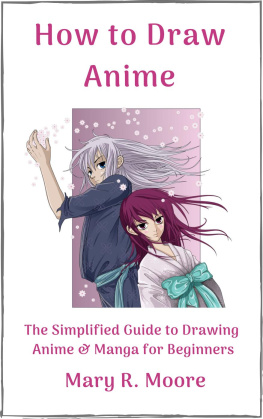
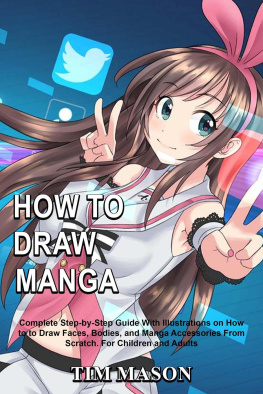

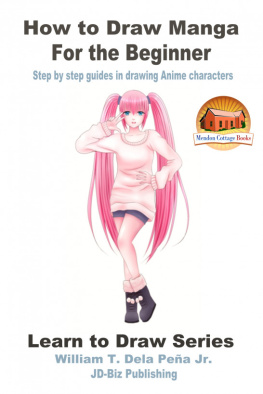
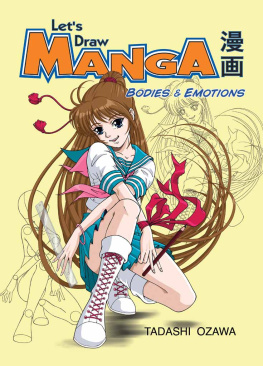
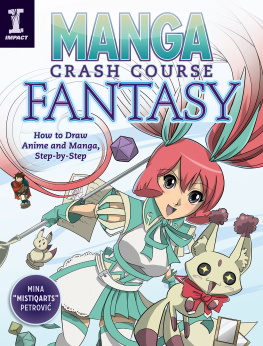
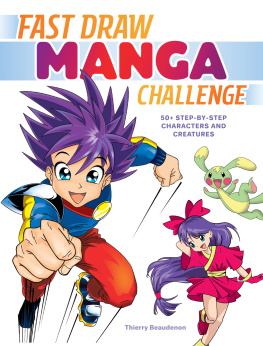

 Copyright 2018 by Danica Davidson and Rena Saiya All rights reserved. No part of this book may be reproduced or stored in a retrieval system or transmitted in any form or by any means, whether electronic, mechanical, photocopying, recording, or other kind, without the express written consent of the publisher, except in the case of brief excerpts in critical reviews or articles. All inquiries should be addressed to Skyhorse Publishing, 307 West 36th Street, 11th Floor, New York, NY 10018. Skyhorse Publishing books may be purchased in bulk at special discounts for sales promotion, corporate gifts, fund-raising, or educational purposes. Special editions can also be created to specifications. For details, contact the Special Sales Department, Skyhorse Publishing, 307 West 36th Street, 11th Floor, New York, NY 10018 or .
Copyright 2018 by Danica Davidson and Rena Saiya All rights reserved. No part of this book may be reproduced or stored in a retrieval system or transmitted in any form or by any means, whether electronic, mechanical, photocopying, recording, or other kind, without the express written consent of the publisher, except in the case of brief excerpts in critical reviews or articles. All inquiries should be addressed to Skyhorse Publishing, 307 West 36th Street, 11th Floor, New York, NY 10018. Skyhorse Publishing books may be purchased in bulk at special discounts for sales promotion, corporate gifts, fund-raising, or educational purposes. Special editions can also be created to specifications. For details, contact the Special Sales Department, Skyhorse Publishing, 307 West 36th Street, 11th Floor, New York, NY 10018 or .